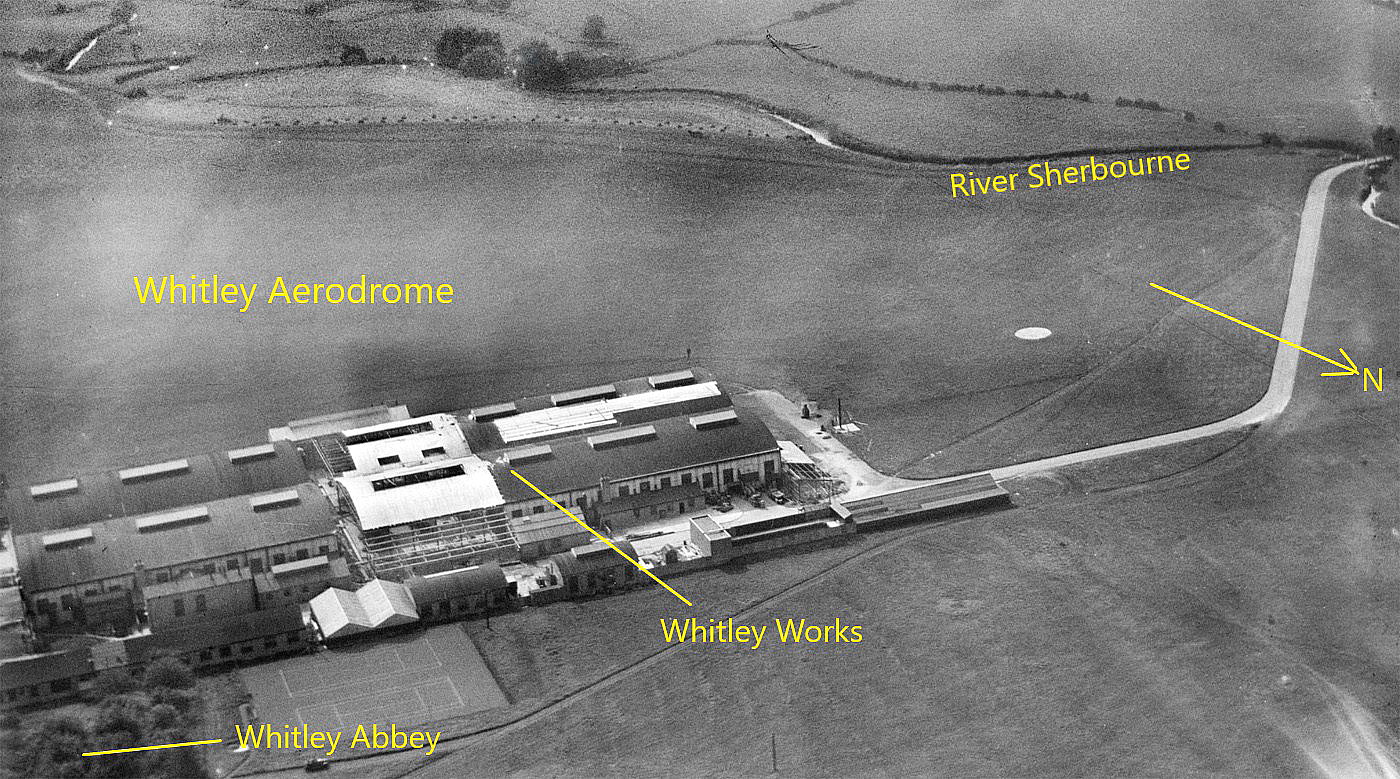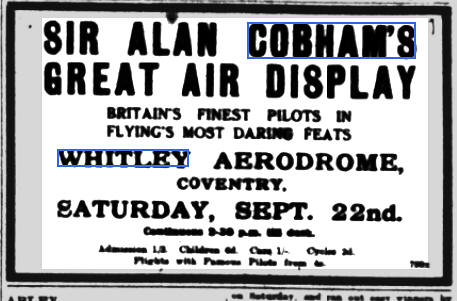Whitley
Note: Some years ago I made this comment. "This map only gives my estimation of the location within the UK. This said, major manufacturing sites rarely move as the basic infrastructure required is already in place, although it may well need improving and updating over time of course. I will welcome any advice on this matter." In February 2021 Mike Holder came to the rescue.
A MICHAEL T HOLDER GALLERY
WHITLEY: Military airfield later civil aerodrome
(Also known as WHITLEY ABBEY)
Military users: RFC/RAF No.1 Aircraft Acceptance Park (Storage)
Civil users: Armstrong Whitworth Aircraft Co & Coventry Aero Club
Note: Armstrong Whitworth formed a flying school for RAF reservists in 1923 which moved to HAMBLE in Hampshire in 1931
Manufacturing: Armstrong Whitworth Aircraft Co for test flying aircraft built in their Parkside factory
Civil operator: From 1920 to ? J.D.Siddeley for use by his Armstrong Whitworth Aircraft Company
Flying school: From 1923 to ? Armstrong Siddeley Motors
Flying club: From 1930 to ? Coventry Aeroplane Club
Location: 1.5nm SE of Coventry
Period of operation: Military: 1917 to 1920 Civil: 1920 (?) to 1936
Site area: 177 acres 731 x 549
NOTES: Originally built by German prisoners of war between 1917 and 1918 it was apparently never used by the Air Ministry for it’s intended purpose.
The Armstrong Whitworth Argosy airliner made it’s first flight here on the 16th March 1926 and it is claimed the type went on to perform sterling service with Imperial Airways.
COVENTRY AERO CLUB
The first aircraft the Coventry Aero Club operated, after starting up in 1930, was the DH 60 Moth G-AAFI, which it appears was flown to the de Havilland facility at WITNEY (OXFORDSHIRE), for overhaul. It seems the rare Southern Martlet G-AAXX was also based here
A QUESTION?
We have yet to find out where Sir Alan Cobham landed in Coventry during his 1929 Municipal Aerodrome Campaign. He was in Coventry on either the 3rd or 4th September, possibly on both days of course. Might it have been that WHITLEY was the chosen venue? Although these were weekdays, the prestige of having Cobham arrive to be greeted by a large group of local dignitaries would no doubt have been seen as quite a coup by the Armstrong Siddeley management.
FLYING CIRCUS VENUES
Note: These three items have been kindly supplied by Mike Holder. The newspaper article was published in the Coventry Evening Telegraph on the 19th May 1933.
Venue, (10th May 1931), for the North British Aviation Co tour of Britain
Venue, (17th July 1932), Sir Alan Cobham’s National Aviation Day UK display tour
Venue, (20th May 1933), British Hospitals Air Pageant
Venue, (22nd September 1934), Sir Alan Cobham's National Aviation Day UK display tour
Some say a Cobham Tour visited in 1931, including in their display the Cierva autogyro G-AAYP - but Cobham didn't have a Tour arranged in 1931.
SOMETHING TO OFTEN BE CORRECTED
Reliable information states that the Armstrong Whitworth Whitley bomber prototype first flew from here, its namesake after all, and not the nearby but later BAGINTON site as is usually stated. After closing as an aerodrome Armstrong Whitworth used the site as offices, stores, stress labs, wind tunnel work, missile research & development work until 1968.
Rob Hargreaves
This comment was written on: 2018-03-01 13:15:50Is it possible that Whitley airfield was use by private aviators in the late 1920's? I have evidence that speedway stars riding at the new track in Coventry at this time, were able to fly directly to Manchester, after an event, in order to compete there the same day. Presumably, you couldn't get your motorbike on a plane in those days? Any info most welcome.
Reply from Dick Flute:
Hi Rob, I shall keep this posted and hopefully somebody can offer advice. Although Whitley was ostensibly a private company airfield I wouldn't be at all surprised if an arrangement could have been made. I think it rather unlikely, but certainly not impossible, that the bikes could have been carried by air if a large enough aircraft was used. But on balance I think that only the riders would have travelled by air. Best regards, Dick
We'd love to hear from you, so please scroll down to leave a comment!
Leave a comment ...
Copyright (c) UK Airfield Guide
























